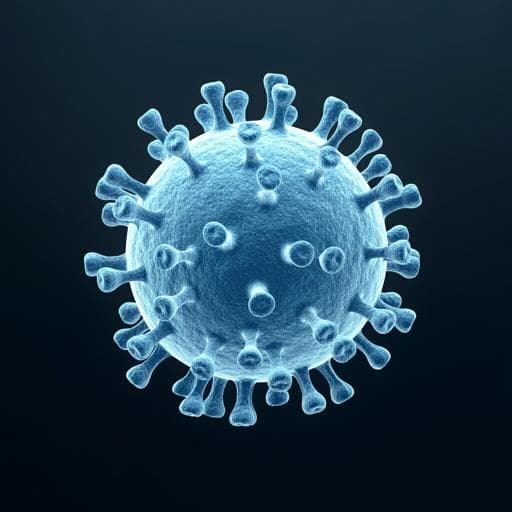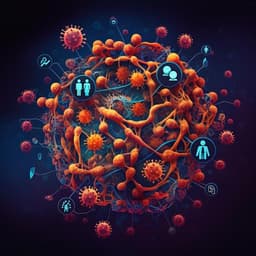
Environmental Studies and Forestry
Role of meteorological factors in the transmission of SARS-CoV-2 in the United States
Y. Ma, S. Pei, et al.
This study conducted by Yiqun Ma, Sen Pei, Jeffrey Shaman, Robert Dubrow, and Kai Chen investigates the intricate relationship between air temperature, specific humidity, ultraviolet radiation, and the transmission of SARS-CoV-2 across 2669 U.S. counties. Discover how cold, dry weather and low UV radiation moderately influence the pandemic's transmissibility.
~3 min • Beginner • English
Introduction
The study investigates whether and to what extent meteorological conditions—air temperature, specific humidity (SH), and ultraviolet (UV) radiation—affect SARS-CoV-2 transmission in the United States. Motivated by laboratory evidence indicating reduced SARS-CoV-2 stability at higher temperatures, higher humidity, and simulated sunlight, and by the known seasonality of influenza and other coronaviruses, the authors hypothesize that lower temperature, lower humidity, and lower UV radiation are associated with increased transmission. Prior ecological studies using reported case counts are limited by underreporting and reporting delays, and early analyses had narrow meteorological ranges and limited confounder control. This study aims to quantify population-level associations using reproduction number estimates that remove the influence of population immunity and to compute the fraction of transmission attributable to deviations in meteorological conditions, while adjusting for extensive spatiotemporal and socioeconomic confounders.
Literature Review
Early studies reported mixed associations between temperature, humidity, and UV radiation and COVID-19 case counts across various regions, often limited by short observation periods, reliance on reported cases or deaths with variable lags and biases, and inadequate control for confounding. Some studies using reproduction numbers found negative associations with temperature and relative humidity, while others found no association in China during early months. A modeling study suggested climate effects would be overshadowed by high susceptibility early in the pandemic. Evidence also points to potential protective roles of UV radiation. The need remained to quantify the fraction of transmission attributable to meteorological factors and to compare the relative importance of temperature, humidity, and UV radiation over a longer timeframe with better confounding control.
Methodology
Study setting and period: 2669 U.S. counties with at least 400 cumulative COVID-19 cases by December 31, 2020, covering March 15–December 31, 2020.
Exposure data: Hourly air temperature and specific humidity from NLDAS (0.125° grid), aggregated to daily county-level means. Daily downward UV radiation (0.20–0.44 μm) from ERA5 reanalysis.
Covariates: County characteristics from multiple sources included geographic coordinates, population density, demographics (age structure, percent Black and Hispanic residents), socioeconomic indicators (median income, education, housing), healthcare capacity (ICU beds), proportion healthcare workers, epidemic stage (day reaching 100 cumulative cases per 100,000), health risk factors (smoking, obesity), long-term PM2.5 (2014–2018 average), short-term air quality (daily PM2.5, daily max 8-h O3), and climate zones. Mobility inputs included county commuting (Census) and inter-county visitors to points of interest (SafeGraph) to inform changes in between-county mixing.
Outcome estimation (reproduction number): A dynamic metapopulation transmission model, informed by commuting and random movement, simulated daytime and nighttime transmission using ODEs. The model explicitly represented reported and unreported infections with different transmissibility, accounted for underreporting, reporting delays (line-list informed), and mapped infections to deaths using age-stratified infection fatality rates. Inter-county movement prior to March 15 used Census commuting data; thereafter, SafeGraph data informed reductions in inter-county visits. Epidemiological parameters (county-specific transmission rate β and ascertainment rate α) were inferred daily via an ensemble adjustment Kalman filter (EAKF) fitted to county-level daily cases and deaths. Fixed parameters drawn from posteriors: D=3.56 days, μ=0.64, Z=3.59 days, δ=0.15. The study computed a reproduction number excluding population susceptibility (Rt = β[α + (1−α)μ]) to remove the influence of changing susceptibility; population susceptibility was estimated and excluded based on validated methods.
Association analysis: A distributed lag non-linear model (DLNM) within a generalized additive mixed model (GAMM) related daily mean temperature, SH, and UV radiation to log-transformed Rt, allowing for non-linear exposure-response and lagged effects up to 13 days. Cross-basis terms for each meteorological factor used natural cubic splines with 3 degrees of freedom (df) for exposure and lag dimensions. Spatial and temporal trends were controlled using tensor product smooths of county centroid coordinates (max 200 knots) and calendar time (max 30 knots). Adjusted covariates included population density, demographic and socioeconomic variables, ICU beds, healthcare workers, and epidemic stage; random effects for county and state (ridge-penalized) further controlled for unmeasured confounding. The model yielded exposure-response curves and identified optimum values (between the 1st and 99th percentiles) associated with minimum Rt. Model diagnostics reported R^2=0.514 and insignificant spatial and temporal autocorrelation of residuals.
Attribution analysis: Using exposure-response functions re-centered at the optimum values, the attributable fraction (AF) and attributable excess of Rt due to deviations in each meteorological factor were computed over cumulative lag (0–13 days) per day and county, then aggregated over time and space. National AFs and monthly AFs were derived, with 95% empirical confidence intervals from 1000 Monte Carlo simulations. The total AF for meteorological factors was the sum of AFs for temperature, SH, and UV.
Sensitivity analyses: Variations included alternative lag spline specification (3 internal knots on log scale), increasing exposure df to 4, reducing time-trend knots to 25, excluding demographic/socioeconomic variables, adjusting for smoking and obesity, climate zones, long-term PM2.5, and short-term PM2.5 and O3. Separate models including each meteorological factor alone were also evaluated.
Key Findings
- Data summary: 19,430,010 COVID-19 cases across 2669 counties; mean daily Rt=1.49 (range 0.45–6.62). Wide ranges for meteorological variables: temperature −22.25 to 39.98 °C; SH 0.49–22.37 g/kg; UV 1.68–155.61 kJ/m^2.
- Temperature: Within 20–40 °C, a roughly linear inverse association with Rt; lower temperatures associated with higher transmission. No significant association below ~10 °C. Compared to the optimum temperature (31.23 °C), 20 °C was associated with a 5.15% (95% CI: 2.49–7.88%) increase in Rt.
- Specific humidity: Non-linear inverse association; higher SH generally associated with lower Rt, with a flat segment from ~7–12 g/kg. Compared to the optimum (19.21 g/kg), the 1st percentile SH (1.80 g/kg) was associated with a 15.20% (95% CI: 9.65–21.04%) increase in Rt.
- UV radiation: Below ~100 kJ/m^2 no clear association; above ~100 kJ/m^2, an approximately linear negative association. A UV level of 100 kJ/m^2 was associated with a 5.18% (95% CI: 2.26–8.17%) increase in Rt versus the optimum (142.78 kJ/m^2).
- Attributable fractions (AF): Temperature AF 3.73% (95% eCI: 3.66–3.76%); SH AF 9.35% (95% eCI: 9.27–9.39%); UV AF 4.44% (95% eCI: 4.38–4.47%). Total AF from all three factors ≈17.5% of Rt.
- Spatial and temporal patterns: AFs generally higher in northern than southern counties; temperature AF higher in eastern U.S. and West Coast; SH AF increases from south to north in the eastern U.S., lower in coastal than interior western counties; UV AF higher in the eastern U.S., lowest in the southwest. AFs highest in winter and lowest in summer; December AF for all meteorological factors combined was 20.8%.
- Model performance: Main model R^2=0.514; residual spatial and temporal autocorrelation insignificant (P=0.159 and 0.798). Sensitivity analyses showed broadly consistent relationships; increasing exposure df to 4 altered the temperature curve, possibly due to overfitting. Long-term PM2.5 adjustment increased temperature AF by ~40%, suggesting confounding by PM2.5 for temperature; SH and UV AFs were stable with this adjustment.
Discussion
The findings support the hypothesis that colder, drier conditions and lower UV radiation are associated with increased SARS-CoV-2 transmissibility. By using reproduction numbers that exclude population susceptibility, a mechanistic transmission model accounting for underreporting and delays, and a DLNM-GAMM framework with extensive confounder control, the study provides robust, population-level evidence quantifying meteorological contributions to transmission. Humidity (SH) emerged as the largest contributor among the three factors, aligning with influenza literature that links absolute humidity with seasonality and virus survival. Laboratory evidence corroborates shorter SARS-CoV-2 half-life at higher temperature and humidity and rapid UV-mediated inactivation, while behavioral factors (more indoor time in winter) and UV effects on immune function may further mediate transmission. Meteorological contributions were most pronounced during winter months and in northern counties, implying seasonal amplification of transmission risk. The identification of PM2.5 as a confounder for temperature (but not SH or UV) suggests SH and UV are more robust predictors in this context. Overall, while meteorology explains a moderate share (~17.5%) of transmissibility, the majority is driven by other factors (e.g., interventions, behavior, susceptibility), underscoring that weather alone does not control epidemic dynamics.
Conclusion
This study quantifies the associations of air temperature, specific humidity, and UV radiation with SARS-CoV-2 transmission across 2669 U.S. counties and estimates that meteorological factors together account for about 17.5% of the reproduction number during March–December 2020, with SH contributing the most. The results indicate higher transmissibility under cold, dry, and low-UV conditions and greater meteorological influence in winter and northern regions. These insights can inform public health planning, emphasizing the need for stronger interventions during colder, drier months. Future research should assess variant-specific meteorological sensitivities, disentangle causal pathways (e.g., indoor vs. outdoor environments, SH vs. temperature interplay), and integrate indoor environmental measurements to refine exposure metrics and mechanistic understanding.
Limitations
- Ecological design precludes individual-level causal inference and may be subject to ecological fallacy.
- Inability to assess heterogeneity of meteorological associations across SARS-CoV-2 variants due to data limitations.
- Although extensive confounders were controlled, residual confounding cannot be ruled out; long-term PM2.5 confounding was evident for temperature.
- Potential measurement error in meteorological reanalysis products and in reproducing true indoor environmental conditions where transmission often occurs.
Related Publications
Explore these studies to deepen your understanding of the subject.







